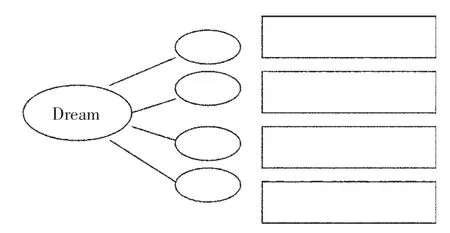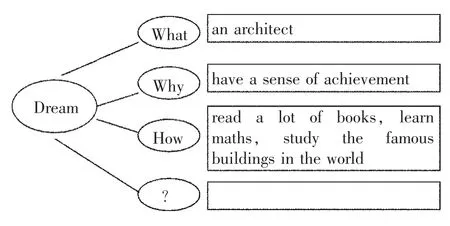提升英语写作教学实效性的策略探讨
写作教学是英语教学的重要方面,随着英语学科核心素养的提出,小学英语写作教学又有了新的方向。笔者曾参加过一次关于写作教学的研讨活动,授课教师执教了译林新版《英语》六下Unit 8 Our dreams的写作教学课,本节课存在的问题也是写作教学中普遍存在的问题,如教师讲授多于学生思考,教师控制性太强,学生没有自主学习和讨论的机会,学生学习力不足;教师未能帮助学生逐步架构文章结构,学生思维水平低下;表达内容少,文章千篇一律,教学过程不够开放,未能帮助学生进行真实的表达,学生语言能力受限;过度关注语言的工具性,忽视了语言的人文性,对于作文中涉及的情感态度价值观缺乏必要的引导等。
针对以上写作教学中存在的问题,笔者仍以该课为例,阐述提升写作教学实效性的相关策略。
一、通过讨论还学生以主体地位
学完本单元,学生对“梦想”这一主题已经具备了一定的语言表达能力。上课伊始,教师呈现 Cartoon time的插图,即描述 Billy,Willy,Bobby和Sam各自梦想的图片(图见教材),开始与学生进行对话。
T:You know who they are,right?But why do I choose the 4 pictures?What’s the topic of them,can you guess?
S1:I think it’s about dreams.
T:Yes,good job.Now I have two questions for you,please discuss in pairs.
Q1:What are their dreams?
Q2:What key sentences can you find?
学生讨论两分钟。
T:Now who can tell us the answers?
S:Billy wants to be a...Willy wants to be a...Bobby wants to be a...And Sam wants to be a...
T:Good.Then,what are the key sentences?
S:He wants to be...She will...He likes...
T:Brilliant,your ideas are cool.
以上教学,教师通过看图猜主题这一任务,让学生围绕学习主题进行思考。教师有意识地让学生找到表达“梦想”的核心句型,有效激活了学生的知识储备,这为写作练笔做好了铺垫。学生通过同桌讨论,激活了大脑中有关梦想表达的知识,同时也让自身的主体地位得以凸显。
二、通过思维导图提升学生思维品质
以上教学明确了写作的主题,但对于写什么、怎么写等问题,学生仍有疑惑。为了解决这一问题,笔者给学生提供了一个空白的思维导图(见图1),让学生通过自主建构,搜集与Dream有关的要素,教学过程如下。

(图1)
T:Now,boys and girls,look at the mind map.First,please think and discuss in pairs,what can we write in the circles?
学生思考并和同桌讨论后,师生交流。
T:Now let’s talk about your ideas.
S1:We can write“What”.
T:What does it mean?
S1:It means“What is the dream?”.
T:That’s good.Anything else?
S2:We can write“Why”.
T:Can you tell us why?
S2:Why means“Why do you want to have this dream?”.
T:Right,that’s the reason.
S3:We can write“How”.
T:What do you mean?
S3:I mean how to make dreams come true.
T:Excellent.Besides these three parts,you can also write something else.So I put a“?”in the last circle.
《义务教育英语课程标准(2011年版)》指出:要为学生提供广阔的思维空间和自主发展空间。在教学中,只有将学生思维能力的培养放在首位,才能不断激活学生的思维,有效地培养学生的学科核心素养。本段教学中,一个不完整的思维导图让学生围绕Dream这一主题发散思维,引导学生在自主分析的基础上逐步架构出文章的结构。如此,学生思维的发散性便能得到培养,思维品质能得以提升。这样的教学让学生从整体上审视语篇内容,通过听同伴们的架构方法,又进一步完善了作文的框架结构,这样学生便解决了写什么的问题,并为接下来的“怎么写”打下了基础。
三、通过拓展生成提升学生语言能力
完成作文的主体框架后,学生需要继续完成思维导图。
T:Now try to finish the mind map,write down your realdreams.Ifyou have any problems,please let me know.
S1:I want to be a建筑设计师,how to say it?
T:Anybody knows?
S2:好像是 architect。
T:That’s cool.How did you know that?(板书 architect)
S2:I learned it in a book.
T:Good job.S1,any other problems?
S1:Why后面的“有成就感”怎么说?
T:Well,this is a little difficult.You can say “I have a sense of achievement”(板书). I think you can also use this in your writing.So,how can you make your dream come true?
S1:I’ll read many books.I’ll have a healthy diet.
T:That’s right.But these are common ideas.Who can tell him some ideas about architect?
S3:You should learn Maths well.(教师板书)
S4:You should draw well.(教师板书)
S5:你要研究世界各地著名的建筑。
T:That’s a good idea.You need to study the famous buildings in the world.(教师板书)
以上教学让思维导图得到了完善,见图2。笔者鼓励学生写出自己的想法,学生的梦想各不相同。面对学生在写作中遇到的困难,笔者敏锐地以此为契机,一方面解决学生的困难,一方面拓展知识。以建筑设计师这一理想为例,笔者适时拓展了单词architect,词组have a sense of achivement,在讨论如何能成为一名建筑设计师时,学生提出的建议也是很好的拓展资源。

(图2)
总之,满足学生的学习需求,适当拓展新词汇和新表达,一方面丰富了学生的语言知识,另一方面也尊重了学生的个性。
四、通过范文学习提升学生学习能力
搭建好作文的框架后,学生开始自己写作。初稿写好后,教师并没有进行查看和讲解,而是呈现了一篇范文,让学生将自己的作文与范文进行对比,并再次将目光转向之前的思维导图,同时和同桌讨论,说说范文的思维导图与学生的思维导图存在哪些共同点和不同点。
T:Most of you have finished the composition,now here’s one,can you find out its mind map?Please discuss in pairs.
范文如下:
My dream
Dreams are like lights.They make our lives bright.
My dream is to be a singer.I like listening to Jay Chou’s songs very much,and I want to be a singer like him.I know it’s not easy,so I’ll study music hard and practise singing every day.I’ll go to a music college.
When I become a famous singer,I’ll have concerts(音乐会)around the world.Concerts make a lot of money,so I’m going to donate(捐献)some to help the children in the poor areas.
T:Who can tell us your ideas?
S1:I think it also has“what”“why”and“how”.
T:You’re right,anything else?
S2:It has开头和end.
T:Excellent.The beginning and the end.Did you find this?
Ss:Yes.
T:Look at our mind map,what can we do?
S3:We can add the beginning and the end.
T:Yes.Did you learn any useful sentences from it?
S4:I learn this:When...I’ll...
T:Good job.
李陆林认为,设计丰富的、合理的、任务明确的合作交流、合作探究活动(任务),能让学生积极、主动、全面、全程、充分地参与到学习活动之中,让学生真正动起来。以上教学,教师对学生写作的指导并没有停留在单词拼写、句子结构的指导上,而是让学生通过对比自己作文与范文,知道了如何让作文框架更合理、完整。
就英语写作而言,信息积累是基础,大量阅读是保证,掌握写作基本要领是前提,用英语思维是关键。范文的学习有助于学生信息的积累,学生从范文中学到了新句型When...I’ll...,这样会让作文更具层次性。
五、通过师生共评培养学生文化品格
在前面的教学中,学生通过思维导图初步完成了作文初稿,通过范文学习完善了作文框架结构,到此,学生已经基本完成了自己的作文。为了进一步提升学生的作文品质,教师还需要给予学生适当的评价。为了避免让学生变成“被评价者”,笔者让学生就作文进行同桌互评,重点关注语言表达的正确性和表达中的亮点。
T:Now please exchange your compositions with your destmates.Focus on:(1)Are there any mistakes in the composition?(2) Is there any shining pionts in the composition?
同桌交换作文进行阅读和评价,教师巡视并解答学生的提问。三分钟后,教师随机选择一篇中等水平学生的作文并投影到大屏幕上,让其同桌进行点评汇报。
S1:I think there’re two mistakes.One is“I want to a cook”.We should say “I want to be a cook”.The other one is“Cook is fun”.We should say“Cooking is fun”.
T:Nice,you have sharp eyes.Did anyone find any shining points in the articles?
S2:Yes,in this compositon,he wrote“When I become a famous basketball player,I’ll give a lot of money to the残疾 children.”
T:残疾 children means disabled children.Boys and girls,do you think this is a shining point?
Ss:Yes.
T:Why do you think so?
S3:Because it’s very good to help the disabled chilren.
T:Yes,love can make the world be better.I hope your dreams can come true soon.
教师并非独自对学生的作文进行评价,而是采用学生互评为主、教师评价为辅的方式。这有效激活了学生的参与热情,让学生体会到了学有所用。此外,在寻找同学作文亮点的过程中,学生发现了语言使用中的人文关怀,有效促进了学生正确人生观和价值观的形成。
英语写作教学是培养学生英语核心素养的重要载体。在教学中,教师应多一些灵动,多给学生提供建构作文结构、自主学习和养成积极的情感态度和价值观的机会,如此,才能让写作教学更有深度、宽度、效度。

